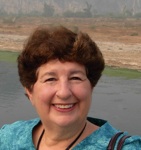This blog piece on Dr. Christine Floss was completed days before her sudden death. It only covers part of her research into the origin of the solar system, but tries to give a sense of the excitement she had in piecing together a picture of our neighborhood in the galaxy just before the formation of our solar system.
When she was first offered the chance to go to Antarctica on a NASA-sponsored expedition to collect meteorites, Christine Floss turned it down. She had children at home, and camping on ice was not on her bucket list. But three years ago NASA invited her again, and her now grown daughters convinced her that she would regret missing the experience.
Floss, a Research Professor of Physics at Washington University, can usually be found in her laboratory working with some of the world’s most advanced instruments to analyze tiny ancient mineral fragments on an atomic level. Her lab is a center for the study of extremely rare samples of the dust cloud that formed our solar system. These presolar grains are occasionally found incorporated into primitive meteorites.
The Antarctic Search for Meteorites (ANSMET) is an annual event that NASA has sponsored since the 1970’s. The aim is to collect as many meteorites of all kinds as possible. “It is a service project, “ explains Floss.
For about a month she and seven fellow adventurers slept in an unheated tent, cooked frozen rations on a Coleman stove in the tent, and spent their days riding Ski-Doos on the blue glacial ice looking for meteorites. Sometimes they would walk the glacial moraines, also rich sources of rocks from outer space. It was one of the high points of her life, she says, even though there was plenty of grousing about the uncomfortable conditions at the time.

